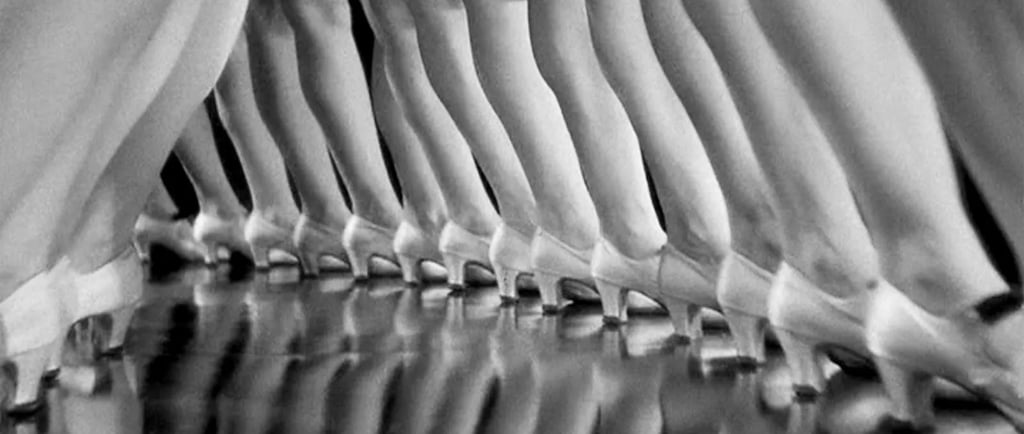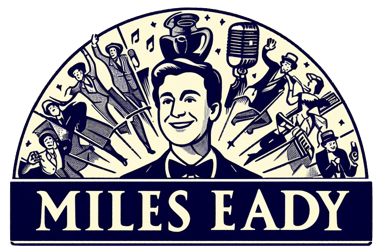Busby Berkeley and the Birth of the Spectacle Musical (1933–1935)
The Joy of Excess


Previous: A Timeline of Movie Musicals →
Next: Fred & Ginger: The Dance Duo Who Changed Hollywood →
Busby Berkeley and the Birth of the Spectacle Musical (1933–1935)
You might not know his name, but you’ve seen his dreams.
If you’ve ever found yourself mesmerised by a geometric swirl of sequined dancers, a camera diving through a sea of legs, or an overhead shot that turns people into chandeliers — you’ve stepped into the kaleidoscopic universe of Busby Berkeley.
Berkeley didn’t choreograph dances so much as he orchestrated fantasies. He made the camera dance. He made mass movement feel like magic. And in doing so, he laid the groundwork for what we now call the spectacle musical.
Who Was Busby Berkeley?
A self-described “dance director” (the word “choreographer” came later), Berkeley was born in 1895 to a stage actress, served in WWI and broke into Hollywood via Broadway. But between 1933 and 1935 — in the depths of the Depression — he found his calling at Warner Bros., where he transformed musicals from fluffy revues into immersive visual hallucinations.
Unlike earlier stage-bound films, Berkeley's numbers often existed outside the plot. This gave him total creative license: he wasn’t filming scenes — he was building impossible spectacles that defied time, gravity, and logic.
What Makes It “Berkeleyesque”?
Overhead Kaleidoscopic Shots – Think of a Busby Berkeley number as a human kaleidoscope in motion.
Abstract Use of the Female Form – Dancers become harps, pinwheels, fountains.
Crane Shots and Floating Cameras – The camera doesn’t observe — it glides, swoops, plunges.
Gigantic Props – Bananas. Coins. Pianos. Exploding chairs. You name it, he made it absurdly big.
Escapist Fantasy – The number becomes its own pocket universe, free from realism.
In short: the story paused and the spectacle took over.
Why It Worked — and Why It Shouldn’t Have
Berkeley’s numbers were too much — and that was the point.
Audiences didn’t want modesty. They wanted abundance.
In an age of soup kitchens and dust bowls, Berkeley offered:
Visual escapism with real bite.
A redefinition of the musical number as ritual, not realism.
A new cinematic language: one where the camera itself danced.
His work influenced everything from Moulin Rouge! to Beyoncé, Dancer in the Dark to TikTok drone videos.
Watch: “By a Waterfall” – Footlight Parade (1933)
One of Berkeley’s most famous numbers, this dreamy aquatic fantasy features synchronised swimmers, invisible gravity and camera moves so bold they still feel modern.
Still live at time of writing — let me know if the link is deleted!
Want to go deeper? Here’s my 10-minute introduction to 42nd Street, filmed at the BFI.
In this video, I explore how this film kicked the genre into gear — with wisecracks, backstage grit, and a finale that made the camera part of the choreography. It’s a film that knows it’s putting on a show — and so does the camera.
And here’s my 10-minute introduction to Footlight Parade.
This is Berkeley at full throttle — fountains, formations, and fantasy sequences that defy physics. In this clip, I break down what makes it special.
Further Reading on Busby Berkeley
Buzz: The Life and Art of Busby Berkeley – Jeffrey Spivak
An engrossing biography that reads like a Hollywood thriller (with more crane shots).
Buy it hereShowstopper: Busby Berkeley and the Tradition of Spectacle – Martin Rubin
A smart, stylish unpacking of his influence and legacy.
Buy it hereThe Genius of Busby Berkeley – John Springer
Less biography, more love letter — rich in images and insight.
Buy it here
Navigate the Series:
Previous: A Timeline of Movie Musicals
Next: Fred & Ginger — Class, Sex Appeal, and Chemistry
In the next post, we move from Berkeley’s dreamworlds to a very different kind of duet: Fred Astaire & Ginger Rogers. They floated like champagne bubbles through the Great Depression — romantic, restrained, and elegant to their fingertips. But how did they offer escapism without the excess



